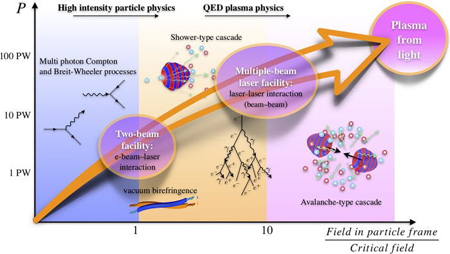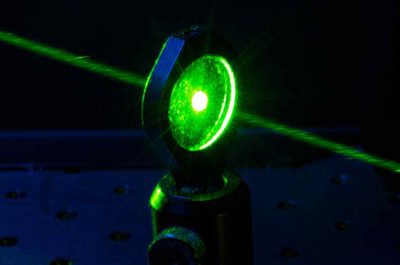Czechia-based laser research center ELI Beamlines, a division the Institute of Physics of Czech Academy of Sciences (FZU), has received funding from the Czech Foundation Agency to develop theoretical tools for modeling experiments at high-power laser facilities.

Timeline of the QED-plasma studies envisioned as a three-stage process with a facility at intermediate laser intensities for the study of fundamental strong-field QED processes, a multi-beam facility at high laser intensities to study the interplay between collective plasma effects and strong-field quantum processes, and a facility based on the laser-plasma collider to study the ultimate limits of SF QED. Image: ELI Beamlines.
The newly-funded collaboration will be conducted through a collaboration between ELI Beamlines and Lawrence Berkeley National Laboratory modeling ELI Beamlines' 1 petawatt L3 HAPLS and upcoming 10 petawatt L4 laser as well as the University of Michigan's upcoming 3 petawatt ZEUS laser.
The researchers plan to develop a roadmap for studying strong field quantum electrodynamics phenomena – like gamma-ray bursts or pulsar magnetospheres – which are not yet fully understood by the scientific community. They describe the research goals and cooperation model as “unique” due to the results that are expected.
The project will be led from ELI Beamlines by Sergei Bulanov, department head of Radiation Physics and Electron Acceleration, and Gabriele Grittani, leader of the Electron Acceleration Group.
The U.S.-based side of the collaboration will be led by Alec Thomas, professor of nuclear engineering and radiological sciences at University of Michigan, and Stepan Bulanov, staff scientist at Lawrence Berkeley National Laboratory.
At ELI Beamlines, Bulanov and Grittani will set up a team to work on the focusing of a laser beam on a single tiny spot to generate an extreme electromagnetic field that will accelerate particles to almost the speed of light and produce a bright gamma-radiation source.
The gamma rays colliding with a strong electromagnetic wave will transform into matter-antimatter particles creating matter from light. The researchers will use these experiments to understand how different types of antimatter can be created, and how even more extreme laser intensities can be studied.
The Czech Science Foundation and The National Science Foundation have partnered to provide funding for this and other projects in the areas of artificial intelligence, nanotechnology, and plasma science.
Strathclyde devises 'simple way' of sculpting matter into complex shapes
A new method for shaping matter into complex shapes, with the use of ‘twisted’ light, has been demonstrated in research at the University of Strathclyde, Glasgow, UK.
The team notes that when atoms are cooled to temperatures close to absolute zero (-273 degrees C), “they stop behaving like particles and start to behave like waves.”

Bose-Einstein Condensates (BECs) are useful for purposes such as realisation of atom lasers, slow light, quantum simulations for understanding the complex behaviour of materials like superconductors and superfluids, and the precision measurement technique of atom interferometry. Image: University of Strathclyde.
Atoms in this condition, which are known as Bose–Einstein condensates (BECs), are useful for purposes such as realisation of atom lasers, slow light, quantum simulations for understanding the complex behaviour of materials like superconductors and superfluids, and the precision measurement technique of atom interferometry.
The Strathclyde study has shown that when twisted light is shone on to a moving BEC, it breaks into clusters of BEC droplets that move following the light’s features, with the number of droplets equal to twice the number of light twists. Altering the properties of the light beam can change both the number of BEC droplets and the way that they move.
The work is described last week in Physical Review Letters.
Grant Henderson, a PhD student in Strathclyde's Department of Physics, is lead author on the paper. He commented, "By shining a laser beam on to a BEC, we can influence how it behaves. When the laser beam is 'twisted', it has a helical phase profile and carries orbital angular momentum (OAM). Laser beams with OAM can trap and rotate microscopic particles, behaving like an optical spanner."
He added, “This method of shining twisted light through ultracold atoms opens a new and simple way of sculpting matter into unconventional and complex shapes. It has the potential for the design of novel quantum devices such as atomtronic circuits and ultra-sensitive detectors.”
News from: https://optics.org/news/13/8/28


